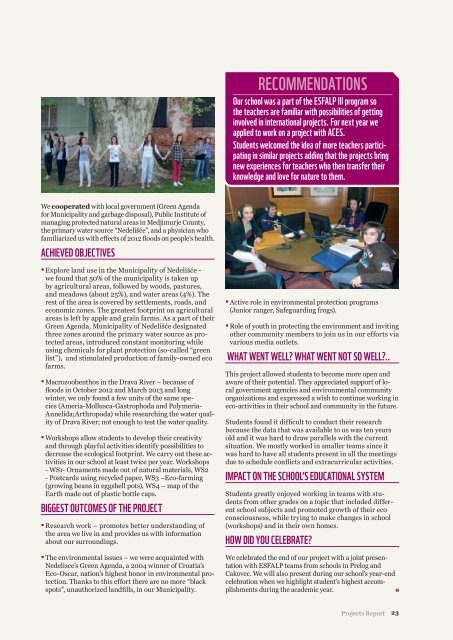esfalp_v_-_web_small.pdf - European schools for a living planet
esfalp_v_-_web_small.pdf - European schools for a living planet
esfalp_v_-_web_small.pdf - European schools for a living planet
- No tags were found...
You also want an ePaper? Increase the reach of your titles
YUMPU automatically turns print PDFs into web optimized ePapers that Google loves.
RECOMMENDATIONSOur school was a part of the ESFALP III program sothe teachers are familiar with possibilities of gettinginvolved in international projects. For next year weapplied to work on a project with ACES.Students welcomed the idea of more teachers participatingin similar projects adding that the projects bringnew experiences <strong>for</strong> teachers who then transfer theirknowledge and love <strong>for</strong> nature to them.We cooperated with local government (Green Agenda<strong>for</strong> Municipality and garbage disposal), Public Institute ofmanaging protected natural areas in Medjimurje County,the primary water source “Nedelišće”, and a physician whofamiliarized us with effects of 2012 floods on people’s health.ACHIEVED OBJECTIVES▪▪Explore land use in the Municipality of Nedelišće -we found that 50% of the municipality is taken upby agricultural areas, followed by woods, pastures,and meadows (about 25%), and water areas (4%). Therest of the area is covered by settlements, roads, andeconomic zones. The greatest footprint on agriculturalareas is left by apple and grain farms. As a part of theirGreen Agenda, Municipality of Nedelišće designatedthree zones around the primary water source as protectedareas, introduced constant monitoring whileusing chemicals <strong>for</strong> plant protection (so-called “greenlist”), and stimulated production of family-owned ecofarms.▪▪Macrozoobenthos in the Drava River – because offloods in October 2012 and March 2013 and longwinter, we only found a few units of the same species(Ameria-Mollusca-Gastrophoda and Polymeria-Annelida;Arthropoda) while researching the water qualityof Drava River; not enough to test the water quality.▪▪Workshops allow students to develop their creativityand through playful activities identify possibilities todecrease the ecological footprint. We carry out these activitiesin our school at least twice per year. Workshops- WS1- Ornaments made out of natural materials, WS2- Postcards using recycled paper, WS3 –Eco-farming(growing beans in eggshell pots), WS4 – map of theEarth made out of plastic bottle caps.BIGGEST OUTCOMES OF THE PROJECT▪▪Research work – promotes better understanding ofthe area we live in and provides us with in<strong>for</strong>mationabout our surroundings.▪▪The environmental issues – we were acquainted withNedelisce’s Green Agenda, a 2004 winner of Croatia’sEco-Oscar, nation’s highest honor in environmental protection.Thanks to this ef<strong>for</strong>t there are no more “blackspots”, unauthorized landfills, in our Municipality.▪▪Active role in environmental protection programs(Junior ranger, Safeguarding frogs).▪▪Role of youth in protecting the environment and invitingother community members to join us in our ef<strong>for</strong>ts viavarious media outlets.WHAT WENT WELL? WHAT WENT NOT SO WELL?..This project allowed students to become more open andaware of their potential. They appreciated support of localgovernment agencies and environmental communityorganizations and expressed a wish to continue working ineco-activities in their school and community in the future.Students found it difficult to conduct their researchbecause the data that was available to us was ten yearsold and it was hard to draw parallels with the currentsituation. We mostly worked in <strong>small</strong>er teams since itwas hard to have all students present in all the meetingsdue to schedule conflicts and extracurricular activities.IMPACT ON THE SCHOOL’S EDUCATIONAL SYSTEMStudents greatly enjoyed working in teams with studentsfrom other grades on a topic that included differentschool subjects and promoted growth of their ecoconsciousness, while trying to make changes in school(workshops) and in their own homes.HOW DID YOU CELEBRATE?We celebrated the end of our project with a joint presentationwith ESFALP teams from <strong>schools</strong> in Prelog andCakovec. We will also present during our school’s year-endcelebration when we highlight student’s highest accomplishmentsduring the academic year.Projects Report 23



